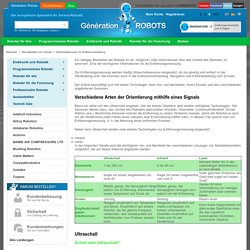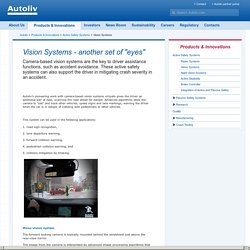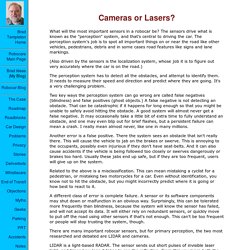

Ultraschallsensoren für Kollisionvermeidung. Ein stetiges Bestreben der Robotik ist es, möglichst viele Informationen über das Umfeld des Roboters zu sammeln.

Eine der wichtigsten Informationen ist die Entfernungsmessung. Zur Entfernungsmessung werden häufig Ultraschallsensoren eingesetzt, da sie günstig und einfach in der Handhabung sind. Sie kommen auch in der Kollisionsvermeidung, Navigation und Kartenerstellung zum Einsatz. Der Artikel beschäftigt sich mit dieser Technologie, ihren Vor- und Nachteilen, ihrem Einsatz und den verschiedenen angebotenen Sensoren. Verschiedene Arten der Orientierung mithilfe eines Signals Bevor wir näher auf den Ultraschall eingehen, hier ein kleiner Überblick über andere verfügbare Technologien. Neben dem Ultraschall werden zwei weitere Technologien zur Entfernungsmessung eingesetzt: : InfrarotLaser In der folgenden Tabelle sind die wichtigsten Vor- und Nachteile der verschiedenen Lösungen von Roboterherstellern aufgeführt, die auf dieser Website angeboten werden. Motorblog » Fahrzeugumfeldsensorik: Überblick und Vergleich zwischen Lidar, Radar, Video.
Niemand würde auf die Idee kommen mit verbundenen Augen und den Händen hinterm Rücken zusammen gebunden, durch die Welt zu laufen und erst auf Hindernisse zu reagieren, wenn die Nase diese berührt.

In etwa so geht es aber dem Auto. In ihm übernehmen Beschleunigungssensoren hinter der Stoßstange die Funktion der Nase. Sebastian Thrun: Google's driverless car. Long-Distance Car Radar. Photos: Bosch.

Untitled. Typical areas of application: Simple anti-collision protection for vehicles of every description (particularly autonomous)Headway control also for far field (vehicles of every description as cranes, construction machinery, fork lifts, tractors, harvester combines….particularly autonomous as AGV, special transporter, module transporter…)Collision avoidance cranes of every description e.g.

STS, RTG, RMG, overhead cranes, gantry cranes…Area monitoring system for far field, e.g. of hazardous or non-accessible areasUnremarkable object detection by affix a protection cover before itClassification of objects (app. 90 single targets)Traffic light approximation recognition, classification of objects (app. 90 single targets)Object detection, e.g. in confusing or unclear areasGeneral distance and speed monitoringRoad traffic technology e.g. traffic light approximation recognitionRail traffic technology, approximation aid for bumper. PresentationGazihan.pdf. Vision Systems. Autoliv’s pioneering work with camera-based vision systems virtually gives the driver an additional pair of eyes, scanning the road ahead for danger.

Dynavis. WAS_Week07_Vehicular_Networks. LeonardJFR08.pdf. Microsoft Word - crane_pap2.doc - DARPA Urban Challenge_FCRAR_08_Crane.pdf. Track and Trace - Track your Item. Why We Need Tesla and Google. "So I think we are making some really good progress on the autopilot side, and I am confident that in less than a year you will be able to go from highway on ramps to highway exits without touching any controls.

" - Elon Musk, CEO, Tesla Motors Consumers are clearly ambivalent about self-driving cars and electric propulsion. Multiple consumer surveys show significant resistance to autonomous vehicles, and enthusiasm for electric vehicles, aside from Tesla’s Model S, has been muted. That’s why we need Tesla and Google. Like Henry Ford, Elon Musk does not make decisions based on consumer surveys, and Google pursues its own ideas about transportation and location awareness beyond the tyranny of the focus group or the legal department. If left to its own devices, the auto industry will study electrification and autonomy to death on the test track without ever bringing an autonomous vehicle (and only a few electric vehicles) to the highway.
Www.unece.org/fileadmin/DAM/trans/doc/2014/wp1/ECE-TRANS-WP1-145e.pdf. Wörterbuch Englisch-Deutsch. SafetyNet_D5 6_Manual_for_DREAM.pdf. Vehicular communication systems. Generally, vehicular networks are considered to contain two types of nodes: vehicles and roadside stations.

Both are dedicated short-range communications (DSRC) devices. DSRC works in 5.9 GHz band with bandwidth of 75 MHz and approximate range of 1000 m.[1] The network should support both private data communications and public (mainly safety) communications but higher priority is given to public communications. Vehicular communications is usually developed as a part of intelligent transportation systems (ITS).
ITS seeks to achieve safety and productivity through intelligent transportation which integrates communication between mobile and fixed nodes. To this end, ITS heavily relies on wired and wireless communications. Motivation[edit] The main motivation for vehicular communication systems is safety and eliminating the excessive cost of traffic collisions. Although the main advantage of vehicular networks is safety improvements, there are several other benefits. Development[edit]
Cameras or Lasers? What will the most important sensors in a robocar be?

The sensors drive what is known as the "perception" system, and that's central to driving the car. The perception system's job is to spot all important things on or near the road like other vehicles, pedestrians, debris and in some cases road features like signs and lane markings. (Also driven by the sensors is the localization system, whose job it is to figure out very accurately where the car is on the road.) The perception system has to detect all the obstacles, and attempt to identify them. It needs to measure their speed and direction and predict where they are going. Two key ways the perception system can go wrong are called false negatives (blindness) and false positives (ghost objects.) Vehicle-to-vehicle. Vehicle-to-vehicle (V2V) is an automobile technology designed to allow automobiles to "talk" to each other.

The systems will use a region of the 5.9 GHz band set aside by the United States Congress in 1999, the unlicensed frequency also used by WiFi. V2V is currently in active development by General Motors, which demonstrated the system in 2006 using Cadillac vehicles. Other automakers working on V2V include Toyota,[1] BMW, Daimler, Honda, Audi, Volvo and the Car-to-Car communication consortium.[2] V2V is also known as VANET (Vehicular ad hoc network). It is a variation of MANET (Mobile ad hoc network), with the emphasis being now the node is the vehicular. In April 2014 it was reported that U.S. regulators were close to approving V2V standards for the U.S. market, and that officials were planning for the technology to become mandatory by 2017.[4] See also[edit] Vehicular communication systems References[edit] Computer Vision.